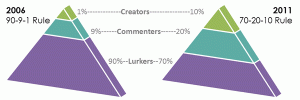We’re all chasing fans and clicks. Fans are our org’s ambassadors, and their click-rate is a way to understand how well we fulfill our mission. New fans give us the opportunity to share more content, and new shares often create new fans.
In setting the social media path for your org, do you think your goals ought to be measured as a target number or a growth rate of likes/shares?
@KevanLee embedded this question in a recent blog post.
Most recognize that it’s key to track growth metrics. And it’s also important to understand which type of content generates clicks and shares.
The target number is easily monitored and can be read as social proof of your org’s success: as one fan likes you, others follow suit. But while large numbers seem meaningful, be careful – in some cases it’s simply copy-catting. From your side of the screen, however, you can differentiate the copy-cat fans from these who deeply engage just by monitoring their shares and clicks.
Growth rate is fuzzier. How well your content permeates beyond the numbered fans is often difficult to pin down. If a fan is having a bad day, they may ignore some of your org’s best content!
It comes down to a discussion of the nuanced differences between increase and engagement – and what is more important to your organization. As Kevan notes, a target number is static, and a growth rate “continues exponentially.”
So, fans or clicks?
Surprisingly, you’ll need to consider both – and they are separate but equal, like the chocolate and peanut butter in a Reese’s peanut butter cup.



